Human Food Choice and Behavior: A Theory of Planned Behavior Analysis
VerifiedAdded on 2023/06/12
|15
|4360
|142
Essay
AI Summary
This essay explores the relationship between human health and food choice behavior, focusing on the Theory of Planned Behavior (TPB) and its influence on dietary decisions. It critiques the TPB, highlighting its limitations in fully explaining food choices, and discusses additional factors such as taste, economic considerations, past experiences, mood, and motivation. The essay argues that while the TPB provides a framework for understanding how attitudes and beliefs shape intentions and behaviors related to food, it needs to incorporate other significant drivers to offer a more comprehensive model of human food choice and its impact on health outcomes. This analysis emphasizes the complexity of food choice and the need for multifaceted approaches to promote healthier eating habits.
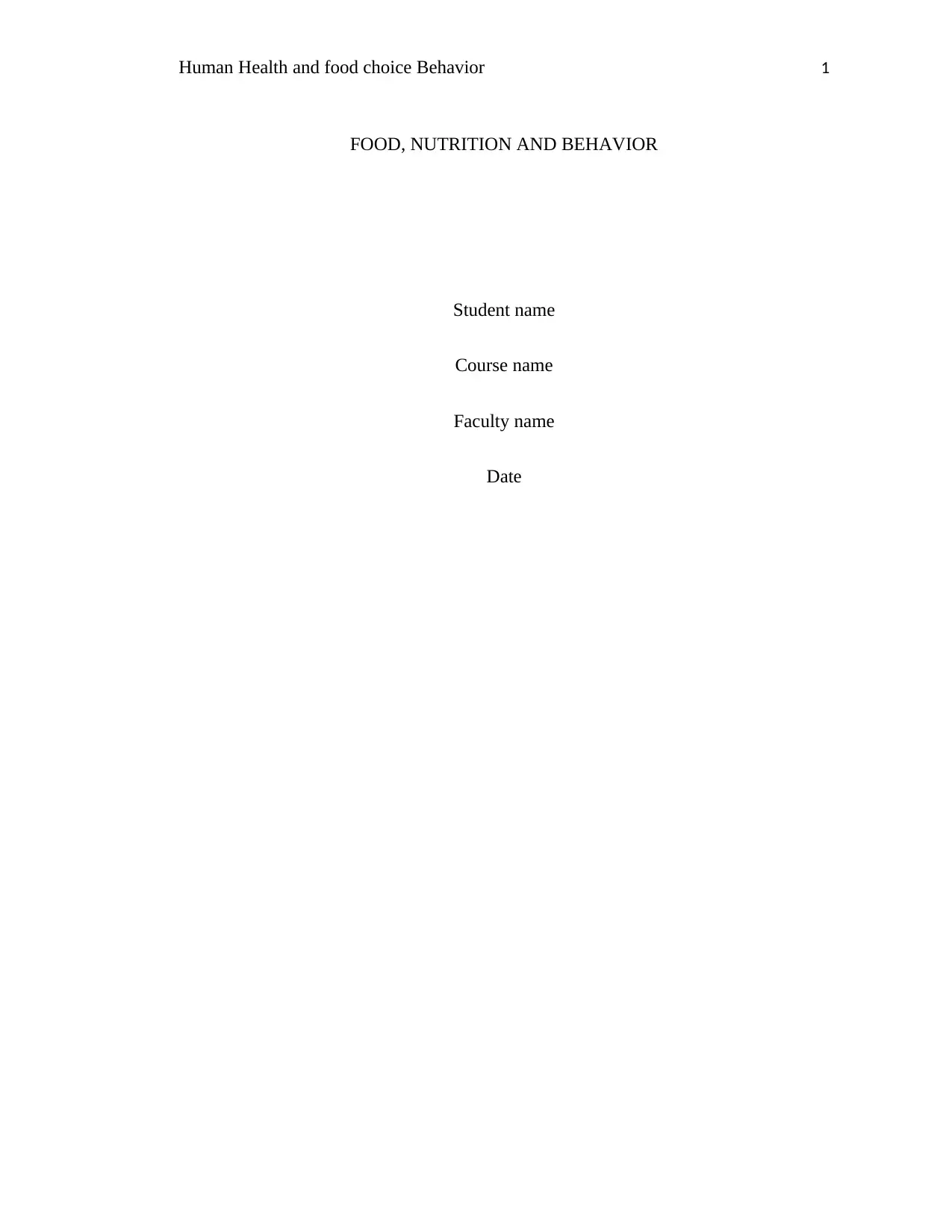
Human Health and food choice Behavior 1
FOOD, NUTRITION AND BEHAVIOR
Student name
Course name
Faculty name
Date
FOOD, NUTRITION AND BEHAVIOR
Student name
Course name
Faculty name
Date
Paraphrase This Document
Need a fresh take? Get an instant paraphrase of this document with our AI Paraphraser
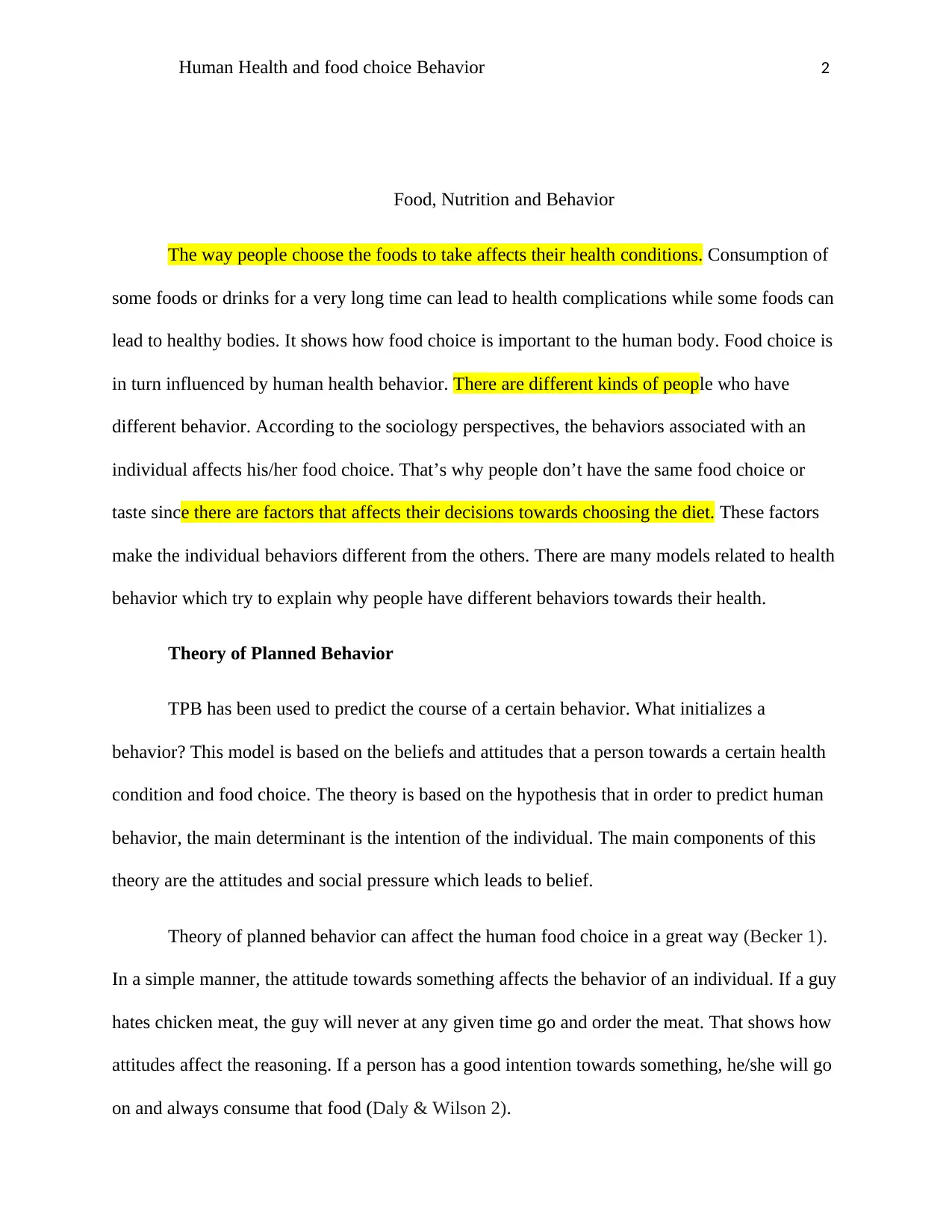
Human Health and food choice Behavior 2
Food, Nutrition and Behavior
The way people choose the foods to take affects their health conditions. Consumption of
some foods or drinks for a very long time can lead to health complications while some foods can
lead to healthy bodies. It shows how food choice is important to the human body. Food choice is
in turn influenced by human health behavior. There are different kinds of people who have
different behavior. According to the sociology perspectives, the behaviors associated with an
individual affects his/her food choice. That’s why people don’t have the same food choice or
taste since there are factors that affects their decisions towards choosing the diet. These factors
make the individual behaviors different from the others. There are many models related to health
behavior which try to explain why people have different behaviors towards their health.
Theory of Planned Behavior
TPB has been used to predict the course of a certain behavior. What initializes a
behavior? This model is based on the beliefs and attitudes that a person towards a certain health
condition and food choice. The theory is based on the hypothesis that in order to predict human
behavior, the main determinant is the intention of the individual. The main components of this
theory are the attitudes and social pressure which leads to belief.
Theory of planned behavior can affect the human food choice in a great way (Becker 1).
In a simple manner, the attitude towards something affects the behavior of an individual. If a guy
hates chicken meat, the guy will never at any given time go and order the meat. That shows how
attitudes affect the reasoning. If a person has a good intention towards something, he/she will go
on and always consume that food (Daly & Wilson 2).
Food, Nutrition and Behavior
The way people choose the foods to take affects their health conditions. Consumption of
some foods or drinks for a very long time can lead to health complications while some foods can
lead to healthy bodies. It shows how food choice is important to the human body. Food choice is
in turn influenced by human health behavior. There are different kinds of people who have
different behavior. According to the sociology perspectives, the behaviors associated with an
individual affects his/her food choice. That’s why people don’t have the same food choice or
taste since there are factors that affects their decisions towards choosing the diet. These factors
make the individual behaviors different from the others. There are many models related to health
behavior which try to explain why people have different behaviors towards their health.
Theory of Planned Behavior
TPB has been used to predict the course of a certain behavior. What initializes a
behavior? This model is based on the beliefs and attitudes that a person towards a certain health
condition and food choice. The theory is based on the hypothesis that in order to predict human
behavior, the main determinant is the intention of the individual. The main components of this
theory are the attitudes and social pressure which leads to belief.
Theory of planned behavior can affect the human food choice in a great way (Becker 1).
In a simple manner, the attitude towards something affects the behavior of an individual. If a guy
hates chicken meat, the guy will never at any given time go and order the meat. That shows how
attitudes affect the reasoning. If a person has a good intention towards something, he/she will go
on and always consume that food (Daly & Wilson 2).
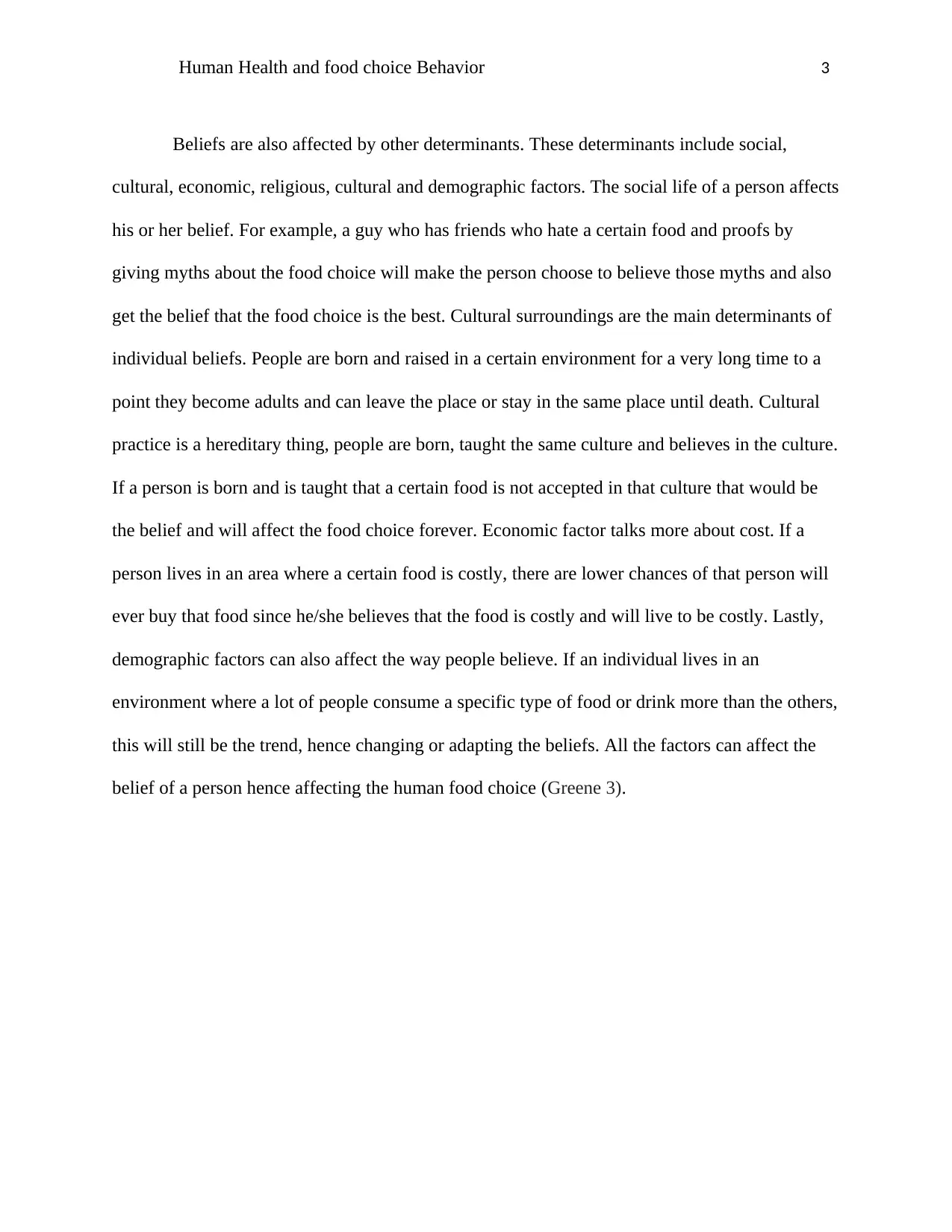
Human Health and food choice Behavior 3
Beliefs are also affected by other determinants. These determinants include social,
cultural, economic, religious, cultural and demographic factors. The social life of a person affects
his or her belief. For example, a guy who has friends who hate a certain food and proofs by
giving myths about the food choice will make the person choose to believe those myths and also
get the belief that the food choice is the best. Cultural surroundings are the main determinants of
individual beliefs. People are born and raised in a certain environment for a very long time to a
point they become adults and can leave the place or stay in the same place until death. Cultural
practice is a hereditary thing, people are born, taught the same culture and believes in the culture.
If a person is born and is taught that a certain food is not accepted in that culture that would be
the belief and will affect the food choice forever. Economic factor talks more about cost. If a
person lives in an area where a certain food is costly, there are lower chances of that person will
ever buy that food since he/she believes that the food is costly and will live to be costly. Lastly,
demographic factors can also affect the way people believe. If an individual lives in an
environment where a lot of people consume a specific type of food or drink more than the others,
this will still be the trend, hence changing or adapting the beliefs. All the factors can affect the
belief of a person hence affecting the human food choice (Greene 3).
Beliefs are also affected by other determinants. These determinants include social,
cultural, economic, religious, cultural and demographic factors. The social life of a person affects
his or her belief. For example, a guy who has friends who hate a certain food and proofs by
giving myths about the food choice will make the person choose to believe those myths and also
get the belief that the food choice is the best. Cultural surroundings are the main determinants of
individual beliefs. People are born and raised in a certain environment for a very long time to a
point they become adults and can leave the place or stay in the same place until death. Cultural
practice is a hereditary thing, people are born, taught the same culture and believes in the culture.
If a person is born and is taught that a certain food is not accepted in that culture that would be
the belief and will affect the food choice forever. Economic factor talks more about cost. If a
person lives in an area where a certain food is costly, there are lower chances of that person will
ever buy that food since he/she believes that the food is costly and will live to be costly. Lastly,
demographic factors can also affect the way people believe. If an individual lives in an
environment where a lot of people consume a specific type of food or drink more than the others,
this will still be the trend, hence changing or adapting the beliefs. All the factors can affect the
belief of a person hence affecting the human food choice (Greene 3).
⊘ This is a preview!⊘
Do you want full access?
Subscribe today to unlock all pages.

Trusted by 1+ million students worldwide
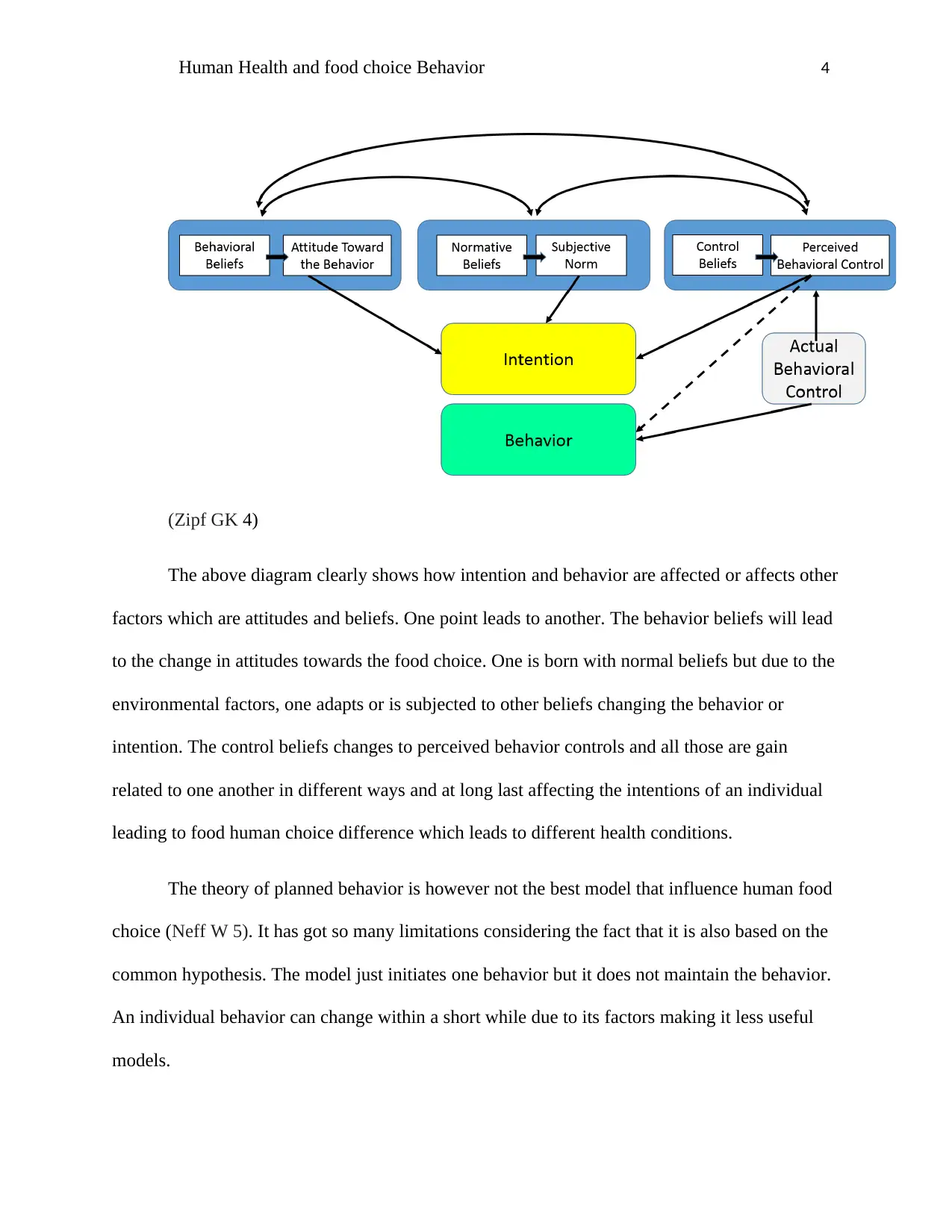
Human Health and food choice Behavior 4
(Zipf GK 4)
The above diagram clearly shows how intention and behavior are affected or affects other
factors which are attitudes and beliefs. One point leads to another. The behavior beliefs will lead
to the change in attitudes towards the food choice. One is born with normal beliefs but due to the
environmental factors, one adapts or is subjected to other beliefs changing the behavior or
intention. The control beliefs changes to perceived behavior controls and all those are gain
related to one another in different ways and at long last affecting the intentions of an individual
leading to food human choice difference which leads to different health conditions.
The theory of planned behavior is however not the best model that influence human food
choice (Neff W 5). It has got so many limitations considering the fact that it is also based on the
common hypothesis. The model just initiates one behavior but it does not maintain the behavior.
An individual behavior can change within a short while due to its factors making it less useful
models.
(Zipf GK 4)
The above diagram clearly shows how intention and behavior are affected or affects other
factors which are attitudes and beliefs. One point leads to another. The behavior beliefs will lead
to the change in attitudes towards the food choice. One is born with normal beliefs but due to the
environmental factors, one adapts or is subjected to other beliefs changing the behavior or
intention. The control beliefs changes to perceived behavior controls and all those are gain
related to one another in different ways and at long last affecting the intentions of an individual
leading to food human choice difference which leads to different health conditions.
The theory of planned behavior is however not the best model that influence human food
choice (Neff W 5). It has got so many limitations considering the fact that it is also based on the
common hypothesis. The model just initiates one behavior but it does not maintain the behavior.
An individual behavior can change within a short while due to its factors making it less useful
models.
Paraphrase This Document
Need a fresh take? Get an instant paraphrase of this document with our AI Paraphraser
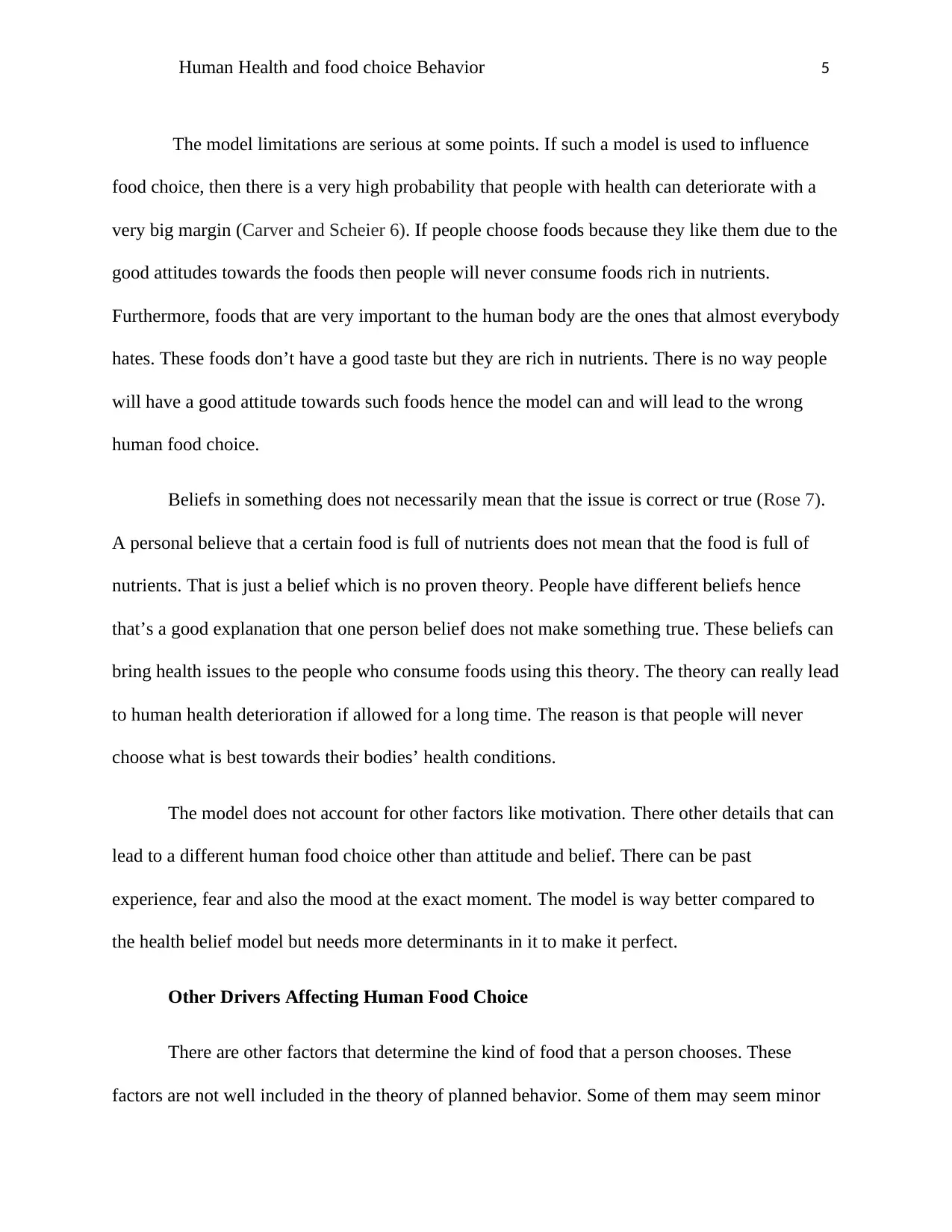
Human Health and food choice Behavior 5
The model limitations are serious at some points. If such a model is used to influence
food choice, then there is a very high probability that people with health can deteriorate with a
very big margin (Carver and Scheier 6). If people choose foods because they like them due to the
good attitudes towards the foods then people will never consume foods rich in nutrients.
Furthermore, foods that are very important to the human body are the ones that almost everybody
hates. These foods don’t have a good taste but they are rich in nutrients. There is no way people
will have a good attitude towards such foods hence the model can and will lead to the wrong
human food choice.
Beliefs in something does not necessarily mean that the issue is correct or true (Rose 7).
A personal believe that a certain food is full of nutrients does not mean that the food is full of
nutrients. That is just a belief which is no proven theory. People have different beliefs hence
that’s a good explanation that one person belief does not make something true. These beliefs can
bring health issues to the people who consume foods using this theory. The theory can really lead
to human health deterioration if allowed for a long time. The reason is that people will never
choose what is best towards their bodies’ health conditions.
The model does not account for other factors like motivation. There other details that can
lead to a different human food choice other than attitude and belief. There can be past
experience, fear and also the mood at the exact moment. The model is way better compared to
the health belief model but needs more determinants in it to make it perfect.
Other Drivers Affecting Human Food Choice
There are other factors that determine the kind of food that a person chooses. These
factors are not well included in the theory of planned behavior. Some of them may seem minor
The model limitations are serious at some points. If such a model is used to influence
food choice, then there is a very high probability that people with health can deteriorate with a
very big margin (Carver and Scheier 6). If people choose foods because they like them due to the
good attitudes towards the foods then people will never consume foods rich in nutrients.
Furthermore, foods that are very important to the human body are the ones that almost everybody
hates. These foods don’t have a good taste but they are rich in nutrients. There is no way people
will have a good attitude towards such foods hence the model can and will lead to the wrong
human food choice.
Beliefs in something does not necessarily mean that the issue is correct or true (Rose 7).
A personal believe that a certain food is full of nutrients does not mean that the food is full of
nutrients. That is just a belief which is no proven theory. People have different beliefs hence
that’s a good explanation that one person belief does not make something true. These beliefs can
bring health issues to the people who consume foods using this theory. The theory can really lead
to human health deterioration if allowed for a long time. The reason is that people will never
choose what is best towards their bodies’ health conditions.
The model does not account for other factors like motivation. There other details that can
lead to a different human food choice other than attitude and belief. There can be past
experience, fear and also the mood at the exact moment. The model is way better compared to
the health belief model but needs more determinants in it to make it perfect.
Other Drivers Affecting Human Food Choice
There are other factors that determine the kind of food that a person chooses. These
factors are not well included in the theory of planned behavior. Some of them may seem minor
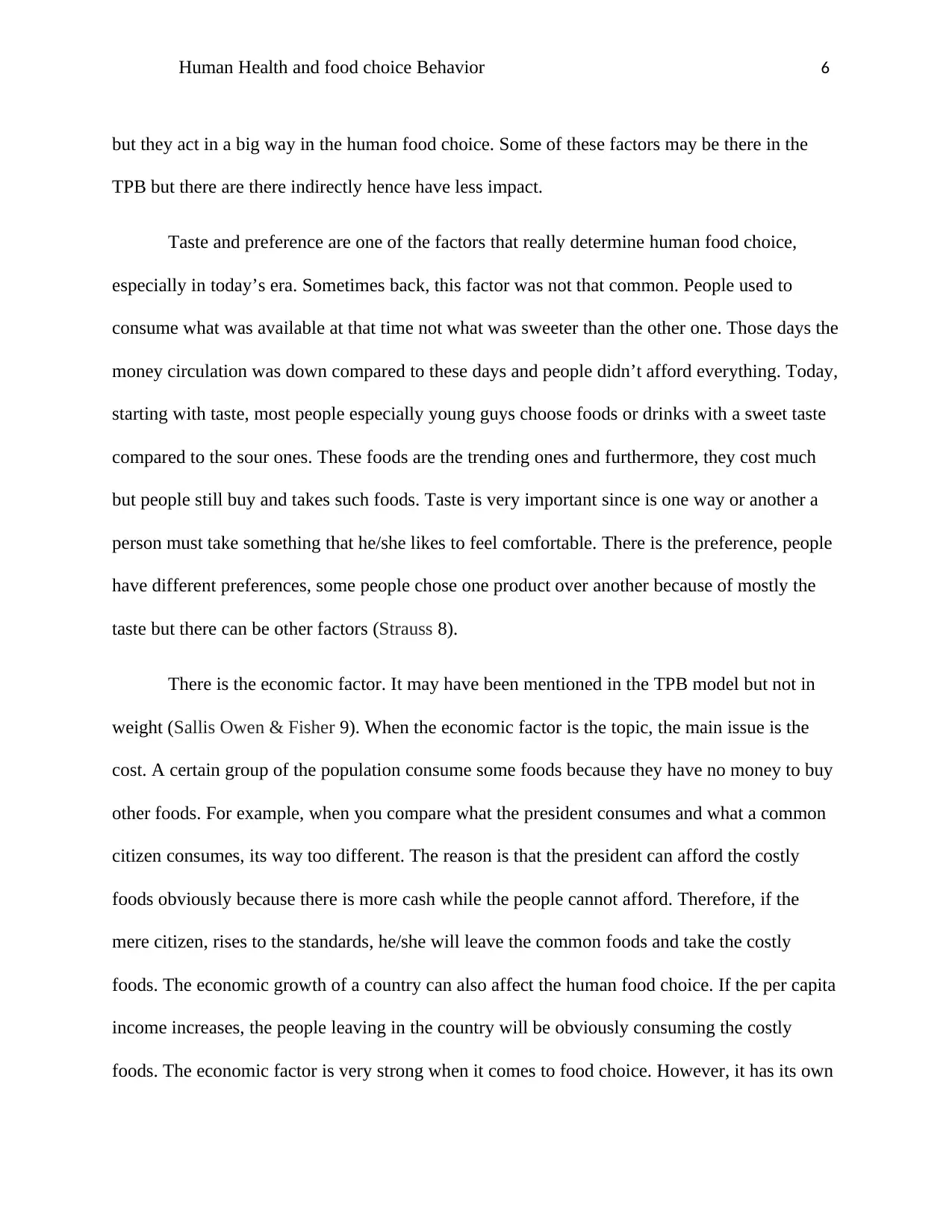
Human Health and food choice Behavior 6
but they act in a big way in the human food choice. Some of these factors may be there in the
TPB but there are there indirectly hence have less impact.
Taste and preference are one of the factors that really determine human food choice,
especially in today’s era. Sometimes back, this factor was not that common. People used to
consume what was available at that time not what was sweeter than the other one. Those days the
money circulation was down compared to these days and people didn’t afford everything. Today,
starting with taste, most people especially young guys choose foods or drinks with a sweet taste
compared to the sour ones. These foods are the trending ones and furthermore, they cost much
but people still buy and takes such foods. Taste is very important since is one way or another a
person must take something that he/she likes to feel comfortable. There is the preference, people
have different preferences, some people chose one product over another because of mostly the
taste but there can be other factors (Strauss 8).
There is the economic factor. It may have been mentioned in the TPB model but not in
weight (Sallis Owen & Fisher 9). When the economic factor is the topic, the main issue is the
cost. A certain group of the population consume some foods because they have no money to buy
other foods. For example, when you compare what the president consumes and what a common
citizen consumes, its way too different. The reason is that the president can afford the costly
foods obviously because there is more cash while the people cannot afford. Therefore, if the
mere citizen, rises to the standards, he/she will leave the common foods and take the costly
foods. The economic growth of a country can also affect the human food choice. If the per capita
income increases, the people leaving in the country will be obviously consuming the costly
foods. The economic factor is very strong when it comes to food choice. However, it has its own
but they act in a big way in the human food choice. Some of these factors may be there in the
TPB but there are there indirectly hence have less impact.
Taste and preference are one of the factors that really determine human food choice,
especially in today’s era. Sometimes back, this factor was not that common. People used to
consume what was available at that time not what was sweeter than the other one. Those days the
money circulation was down compared to these days and people didn’t afford everything. Today,
starting with taste, most people especially young guys choose foods or drinks with a sweet taste
compared to the sour ones. These foods are the trending ones and furthermore, they cost much
but people still buy and takes such foods. Taste is very important since is one way or another a
person must take something that he/she likes to feel comfortable. There is the preference, people
have different preferences, some people chose one product over another because of mostly the
taste but there can be other factors (Strauss 8).
There is the economic factor. It may have been mentioned in the TPB model but not in
weight (Sallis Owen & Fisher 9). When the economic factor is the topic, the main issue is the
cost. A certain group of the population consume some foods because they have no money to buy
other foods. For example, when you compare what the president consumes and what a common
citizen consumes, its way too different. The reason is that the president can afford the costly
foods obviously because there is more cash while the people cannot afford. Therefore, if the
mere citizen, rises to the standards, he/she will leave the common foods and take the costly
foods. The economic growth of a country can also affect the human food choice. If the per capita
income increases, the people leaving in the country will be obviously consuming the costly
foods. The economic factor is very strong when it comes to food choice. However, it has its own
⊘ This is a preview!⊘
Do you want full access?
Subscribe today to unlock all pages.

Trusted by 1+ million students worldwide
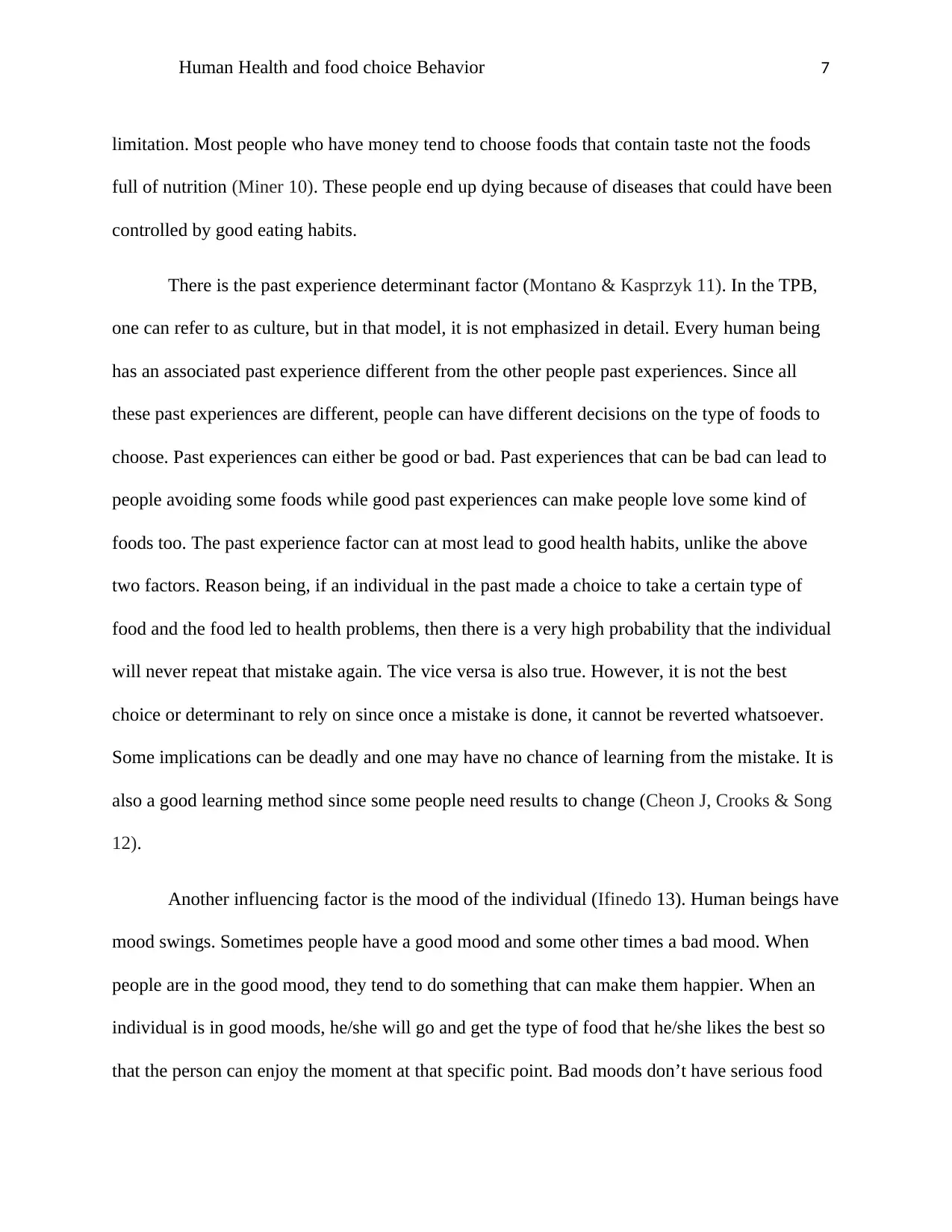
Human Health and food choice Behavior 7
limitation. Most people who have money tend to choose foods that contain taste not the foods
full of nutrition (Miner 10). These people end up dying because of diseases that could have been
controlled by good eating habits.
There is the past experience determinant factor (Montano & Kasprzyk 11). In the TPB,
one can refer to as culture, but in that model, it is not emphasized in detail. Every human being
has an associated past experience different from the other people past experiences. Since all
these past experiences are different, people can have different decisions on the type of foods to
choose. Past experiences can either be good or bad. Past experiences that can be bad can lead to
people avoiding some foods while good past experiences can make people love some kind of
foods too. The past experience factor can at most lead to good health habits, unlike the above
two factors. Reason being, if an individual in the past made a choice to take a certain type of
food and the food led to health problems, then there is a very high probability that the individual
will never repeat that mistake again. The vice versa is also true. However, it is not the best
choice or determinant to rely on since once a mistake is done, it cannot be reverted whatsoever.
Some implications can be deadly and one may have no chance of learning from the mistake. It is
also a good learning method since some people need results to change (Cheon J, Crooks & Song
12).
Another influencing factor is the mood of the individual (Ifinedo 13). Human beings have
mood swings. Sometimes people have a good mood and some other times a bad mood. When
people are in the good mood, they tend to do something that can make them happier. When an
individual is in good moods, he/she will go and get the type of food that he/she likes the best so
that the person can enjoy the moment at that specific point. Bad moods don’t have serious food
limitation. Most people who have money tend to choose foods that contain taste not the foods
full of nutrition (Miner 10). These people end up dying because of diseases that could have been
controlled by good eating habits.
There is the past experience determinant factor (Montano & Kasprzyk 11). In the TPB,
one can refer to as culture, but in that model, it is not emphasized in detail. Every human being
has an associated past experience different from the other people past experiences. Since all
these past experiences are different, people can have different decisions on the type of foods to
choose. Past experiences can either be good or bad. Past experiences that can be bad can lead to
people avoiding some foods while good past experiences can make people love some kind of
foods too. The past experience factor can at most lead to good health habits, unlike the above
two factors. Reason being, if an individual in the past made a choice to take a certain type of
food and the food led to health problems, then there is a very high probability that the individual
will never repeat that mistake again. The vice versa is also true. However, it is not the best
choice or determinant to rely on since once a mistake is done, it cannot be reverted whatsoever.
Some implications can be deadly and one may have no chance of learning from the mistake. It is
also a good learning method since some people need results to change (Cheon J, Crooks & Song
12).
Another influencing factor is the mood of the individual (Ifinedo 13). Human beings have
mood swings. Sometimes people have a good mood and some other times a bad mood. When
people are in the good mood, they tend to do something that can make them happier. When an
individual is in good moods, he/she will go and get the type of food that he/she likes the best so
that the person can enjoy the moment at that specific point. Bad moods don’t have serious food
Paraphrase This Document
Need a fresh take? Get an instant paraphrase of this document with our AI Paraphraser
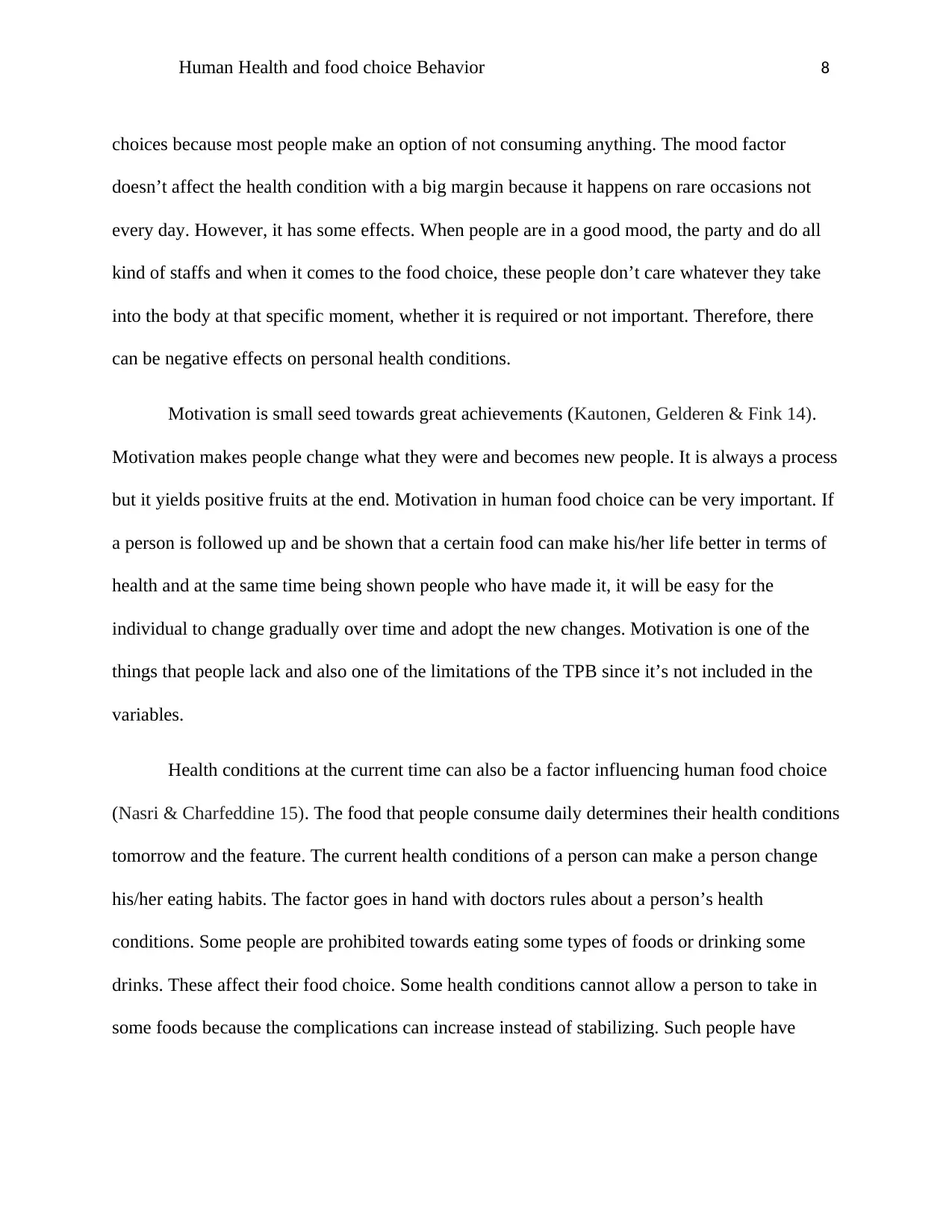
Human Health and food choice Behavior 8
choices because most people make an option of not consuming anything. The mood factor
doesn’t affect the health condition with a big margin because it happens on rare occasions not
every day. However, it has some effects. When people are in a good mood, the party and do all
kind of staffs and when it comes to the food choice, these people don’t care whatever they take
into the body at that specific moment, whether it is required or not important. Therefore, there
can be negative effects on personal health conditions.
Motivation is small seed towards great achievements (Kautonen, Gelderen & Fink 14).
Motivation makes people change what they were and becomes new people. It is always a process
but it yields positive fruits at the end. Motivation in human food choice can be very important. If
a person is followed up and be shown that a certain food can make his/her life better in terms of
health and at the same time being shown people who have made it, it will be easy for the
individual to change gradually over time and adopt the new changes. Motivation is one of the
things that people lack and also one of the limitations of the TPB since it’s not included in the
variables.
Health conditions at the current time can also be a factor influencing human food choice
(Nasri & Charfeddine 15). The food that people consume daily determines their health conditions
tomorrow and the feature. The current health conditions of a person can make a person change
his/her eating habits. The factor goes in hand with doctors rules about a person’s health
conditions. Some people are prohibited towards eating some types of foods or drinking some
drinks. These affect their food choice. Some health conditions cannot allow a person to take in
some foods because the complications can increase instead of stabilizing. Such people have
choices because most people make an option of not consuming anything. The mood factor
doesn’t affect the health condition with a big margin because it happens on rare occasions not
every day. However, it has some effects. When people are in a good mood, the party and do all
kind of staffs and when it comes to the food choice, these people don’t care whatever they take
into the body at that specific moment, whether it is required or not important. Therefore, there
can be negative effects on personal health conditions.
Motivation is small seed towards great achievements (Kautonen, Gelderen & Fink 14).
Motivation makes people change what they were and becomes new people. It is always a process
but it yields positive fruits at the end. Motivation in human food choice can be very important. If
a person is followed up and be shown that a certain food can make his/her life better in terms of
health and at the same time being shown people who have made it, it will be easy for the
individual to change gradually over time and adopt the new changes. Motivation is one of the
things that people lack and also one of the limitations of the TPB since it’s not included in the
variables.
Health conditions at the current time can also be a factor influencing human food choice
(Nasri & Charfeddine 15). The food that people consume daily determines their health conditions
tomorrow and the feature. The current health conditions of a person can make a person change
his/her eating habits. The factor goes in hand with doctors rules about a person’s health
conditions. Some people are prohibited towards eating some types of foods or drinking some
drinks. These affect their food choice. Some health conditions cannot allow a person to take in
some foods because the complications can increase instead of stabilizing. Such people have
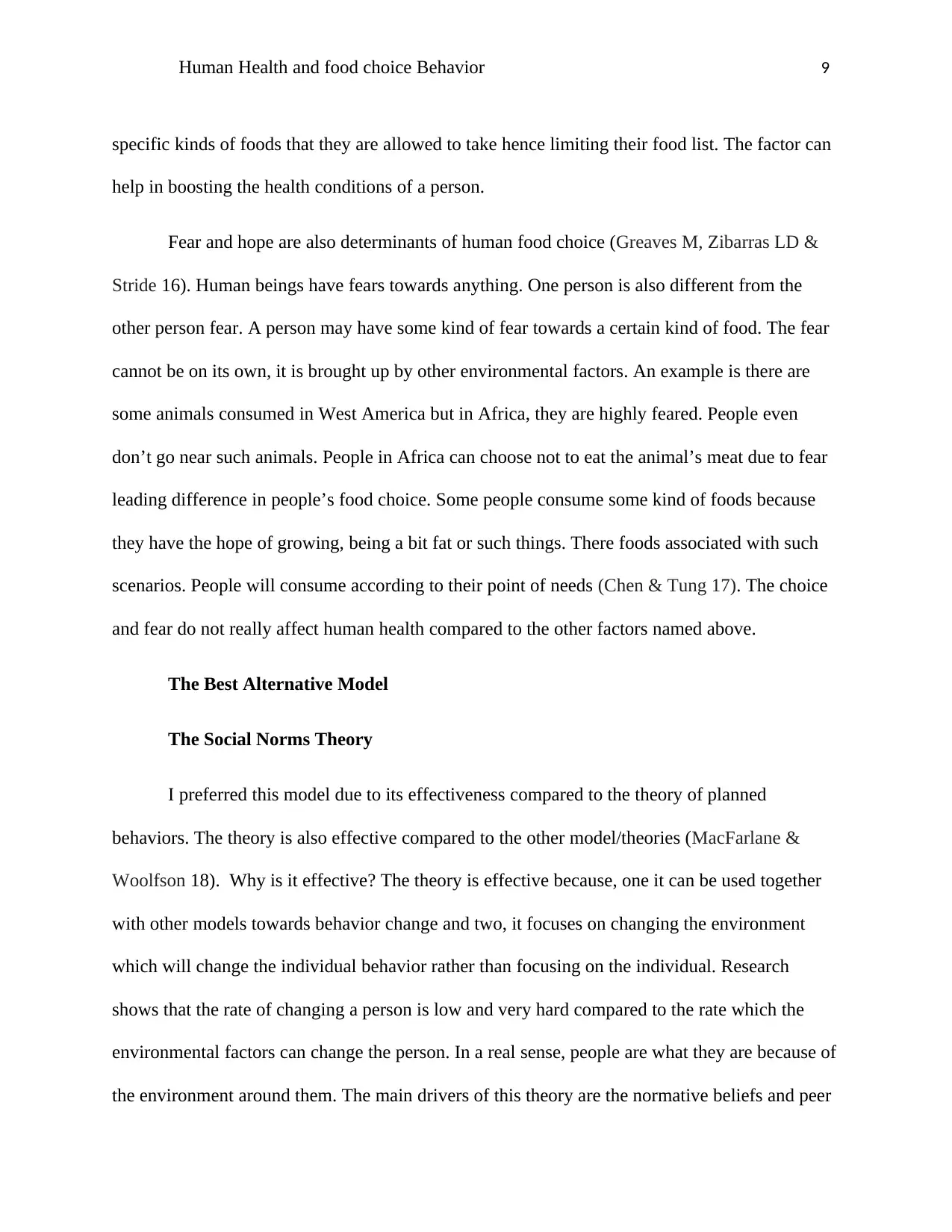
Human Health and food choice Behavior 9
specific kinds of foods that they are allowed to take hence limiting their food list. The factor can
help in boosting the health conditions of a person.
Fear and hope are also determinants of human food choice (Greaves M, Zibarras LD &
Stride 16). Human beings have fears towards anything. One person is also different from the
other person fear. A person may have some kind of fear towards a certain kind of food. The fear
cannot be on its own, it is brought up by other environmental factors. An example is there are
some animals consumed in West America but in Africa, they are highly feared. People even
don’t go near such animals. People in Africa can choose not to eat the animal’s meat due to fear
leading difference in people’s food choice. Some people consume some kind of foods because
they have the hope of growing, being a bit fat or such things. There foods associated with such
scenarios. People will consume according to their point of needs (Chen & Tung 17). The choice
and fear do not really affect human health compared to the other factors named above.
The Best Alternative Model
The Social Norms Theory
I preferred this model due to its effectiveness compared to the theory of planned
behaviors. The theory is also effective compared to the other model/theories (MacFarlane &
Woolfson 18). Why is it effective? The theory is effective because, one it can be used together
with other models towards behavior change and two, it focuses on changing the environment
which will change the individual behavior rather than focusing on the individual. Research
shows that the rate of changing a person is low and very hard compared to the rate which the
environmental factors can change the person. In a real sense, people are what they are because of
the environment around them. The main drivers of this theory are the normative beliefs and peer
specific kinds of foods that they are allowed to take hence limiting their food list. The factor can
help in boosting the health conditions of a person.
Fear and hope are also determinants of human food choice (Greaves M, Zibarras LD &
Stride 16). Human beings have fears towards anything. One person is also different from the
other person fear. A person may have some kind of fear towards a certain kind of food. The fear
cannot be on its own, it is brought up by other environmental factors. An example is there are
some animals consumed in West America but in Africa, they are highly feared. People even
don’t go near such animals. People in Africa can choose not to eat the animal’s meat due to fear
leading difference in people’s food choice. Some people consume some kind of foods because
they have the hope of growing, being a bit fat or such things. There foods associated with such
scenarios. People will consume according to their point of needs (Chen & Tung 17). The choice
and fear do not really affect human health compared to the other factors named above.
The Best Alternative Model
The Social Norms Theory
I preferred this model due to its effectiveness compared to the theory of planned
behaviors. The theory is also effective compared to the other model/theories (MacFarlane &
Woolfson 18). Why is it effective? The theory is effective because, one it can be used together
with other models towards behavior change and two, it focuses on changing the environment
which will change the individual behavior rather than focusing on the individual. Research
shows that the rate of changing a person is low and very hard compared to the rate which the
environmental factors can change the person. In a real sense, people are what they are because of
the environment around them. The main drivers of this theory are the normative beliefs and peer
⊘ This is a preview!⊘
Do you want full access?
Subscribe today to unlock all pages.

Trusted by 1+ million students worldwide
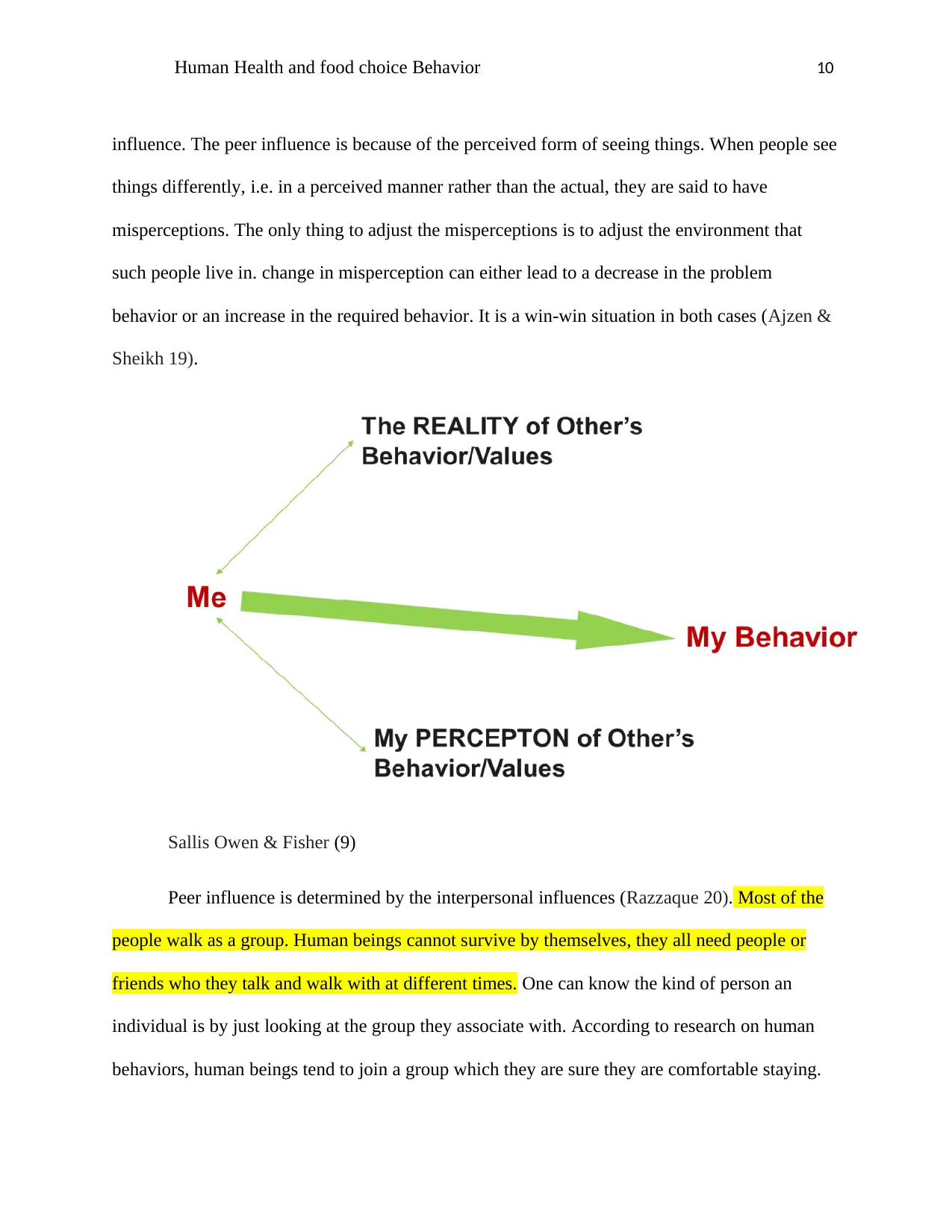
Human Health and food choice Behavior 10
influence. The peer influence is because of the perceived form of seeing things. When people see
things differently, i.e. in a perceived manner rather than the actual, they are said to have
misperceptions. The only thing to adjust the misperceptions is to adjust the environment that
such people live in. change in misperception can either lead to a decrease in the problem
behavior or an increase in the required behavior. It is a win-win situation in both cases (Ajzen &
Sheikh 19).
Sallis Owen & Fisher (9)
Peer influence is determined by the interpersonal influences (Razzaque 20). Most of the
people walk as a group. Human beings cannot survive by themselves, they all need people or
friends who they talk and walk with at different times. One can know the kind of person an
individual is by just looking at the group they associate with. According to research on human
behaviors, human beings tend to join a group which they are sure they are comfortable staying.
influence. The peer influence is because of the perceived form of seeing things. When people see
things differently, i.e. in a perceived manner rather than the actual, they are said to have
misperceptions. The only thing to adjust the misperceptions is to adjust the environment that
such people live in. change in misperception can either lead to a decrease in the problem
behavior or an increase in the required behavior. It is a win-win situation in both cases (Ajzen &
Sheikh 19).
Sallis Owen & Fisher (9)
Peer influence is determined by the interpersonal influences (Razzaque 20). Most of the
people walk as a group. Human beings cannot survive by themselves, they all need people or
friends who they talk and walk with at different times. One can know the kind of person an
individual is by just looking at the group they associate with. According to research on human
behaviors, human beings tend to join a group which they are sure they are comfortable staying.
Paraphrase This Document
Need a fresh take? Get an instant paraphrase of this document with our AI Paraphraser
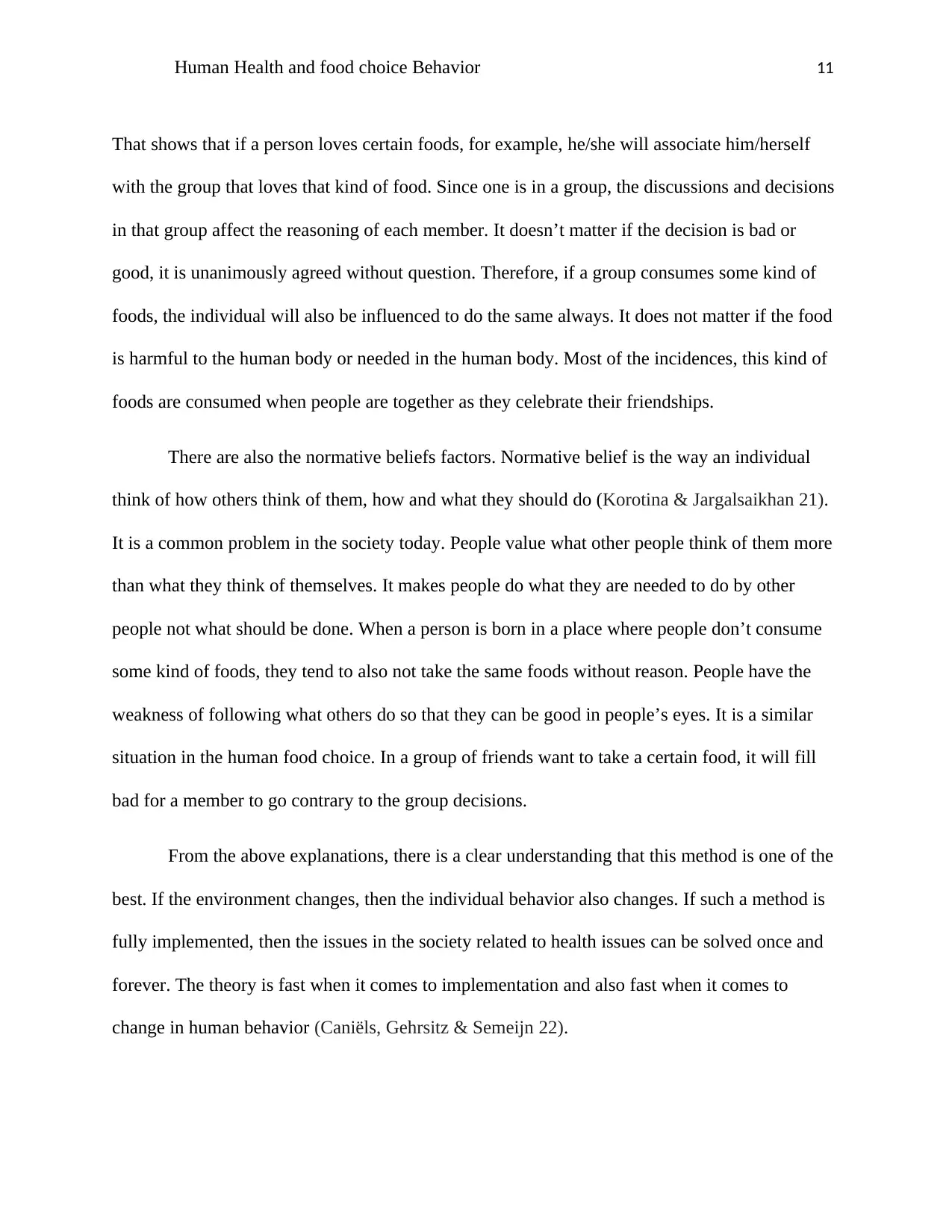
Human Health and food choice Behavior 11
That shows that if a person loves certain foods, for example, he/she will associate him/herself
with the group that loves that kind of food. Since one is in a group, the discussions and decisions
in that group affect the reasoning of each member. It doesn’t matter if the decision is bad or
good, it is unanimously agreed without question. Therefore, if a group consumes some kind of
foods, the individual will also be influenced to do the same always. It does not matter if the food
is harmful to the human body or needed in the human body. Most of the incidences, this kind of
foods are consumed when people are together as they celebrate their friendships.
There are also the normative beliefs factors. Normative belief is the way an individual
think of how others think of them, how and what they should do (Korotina & Jargalsaikhan 21).
It is a common problem in the society today. People value what other people think of them more
than what they think of themselves. It makes people do what they are needed to do by other
people not what should be done. When a person is born in a place where people don’t consume
some kind of foods, they tend to also not take the same foods without reason. People have the
weakness of following what others do so that they can be good in people’s eyes. It is a similar
situation in the human food choice. In a group of friends want to take a certain food, it will fill
bad for a member to go contrary to the group decisions.
From the above explanations, there is a clear understanding that this method is one of the
best. If the environment changes, then the individual behavior also changes. If such a method is
fully implemented, then the issues in the society related to health issues can be solved once and
forever. The theory is fast when it comes to implementation and also fast when it comes to
change in human behavior (Caniëls, Gehrsitz & Semeijn 22).
That shows that if a person loves certain foods, for example, he/she will associate him/herself
with the group that loves that kind of food. Since one is in a group, the discussions and decisions
in that group affect the reasoning of each member. It doesn’t matter if the decision is bad or
good, it is unanimously agreed without question. Therefore, if a group consumes some kind of
foods, the individual will also be influenced to do the same always. It does not matter if the food
is harmful to the human body or needed in the human body. Most of the incidences, this kind of
foods are consumed when people are together as they celebrate their friendships.
There are also the normative beliefs factors. Normative belief is the way an individual
think of how others think of them, how and what they should do (Korotina & Jargalsaikhan 21).
It is a common problem in the society today. People value what other people think of them more
than what they think of themselves. It makes people do what they are needed to do by other
people not what should be done. When a person is born in a place where people don’t consume
some kind of foods, they tend to also not take the same foods without reason. People have the
weakness of following what others do so that they can be good in people’s eyes. It is a similar
situation in the human food choice. In a group of friends want to take a certain food, it will fill
bad for a member to go contrary to the group decisions.
From the above explanations, there is a clear understanding that this method is one of the
best. If the environment changes, then the individual behavior also changes. If such a method is
fully implemented, then the issues in the society related to health issues can be solved once and
forever. The theory is fast when it comes to implementation and also fast when it comes to
change in human behavior (Caniëls, Gehrsitz & Semeijn 22).
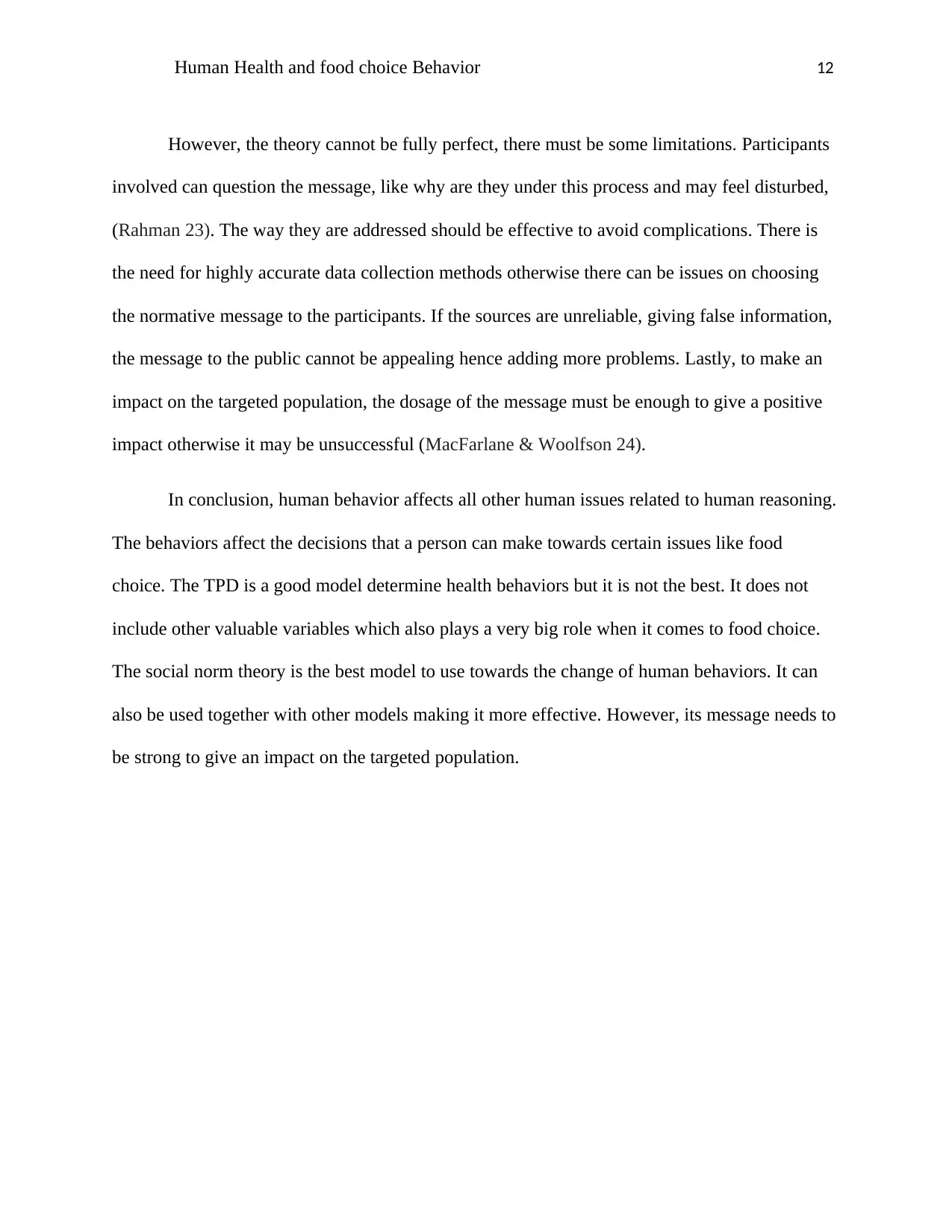
Human Health and food choice Behavior 12
However, the theory cannot be fully perfect, there must be some limitations. Participants
involved can question the message, like why are they under this process and may feel disturbed,
(Rahman 23). The way they are addressed should be effective to avoid complications. There is
the need for highly accurate data collection methods otherwise there can be issues on choosing
the normative message to the participants. If the sources are unreliable, giving false information,
the message to the public cannot be appealing hence adding more problems. Lastly, to make an
impact on the targeted population, the dosage of the message must be enough to give a positive
impact otherwise it may be unsuccessful (MacFarlane & Woolfson 24).
In conclusion, human behavior affects all other human issues related to human reasoning.
The behaviors affect the decisions that a person can make towards certain issues like food
choice. The TPD is a good model determine health behaviors but it is not the best. It does not
include other valuable variables which also plays a very big role when it comes to food choice.
The social norm theory is the best model to use towards the change of human behaviors. It can
also be used together with other models making it more effective. However, its message needs to
be strong to give an impact on the targeted population.
However, the theory cannot be fully perfect, there must be some limitations. Participants
involved can question the message, like why are they under this process and may feel disturbed,
(Rahman 23). The way they are addressed should be effective to avoid complications. There is
the need for highly accurate data collection methods otherwise there can be issues on choosing
the normative message to the participants. If the sources are unreliable, giving false information,
the message to the public cannot be appealing hence adding more problems. Lastly, to make an
impact on the targeted population, the dosage of the message must be enough to give a positive
impact otherwise it may be unsuccessful (MacFarlane & Woolfson 24).
In conclusion, human behavior affects all other human issues related to human reasoning.
The behaviors affect the decisions that a person can make towards certain issues like food
choice. The TPD is a good model determine health behaviors but it is not the best. It does not
include other valuable variables which also plays a very big role when it comes to food choice.
The social norm theory is the best model to use towards the change of human behaviors. It can
also be used together with other models making it more effective. However, its message needs to
be strong to give an impact on the targeted population.
⊘ This is a preview!⊘
Do you want full access?
Subscribe today to unlock all pages.

Trusted by 1+ million students worldwide
1 out of 15
Related Documents
Your All-in-One AI-Powered Toolkit for Academic Success.
+13062052269
info@desklib.com
Available 24*7 on WhatsApp / Email
![[object Object]](/_next/static/media/star-bottom.7253800d.svg)
Unlock your academic potential
Copyright © 2020–2025 A2Z Services. All Rights Reserved. Developed and managed by ZUCOL.





